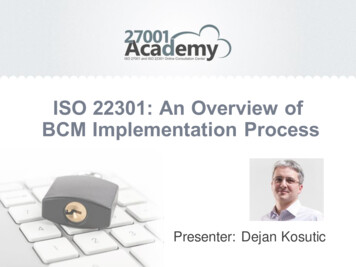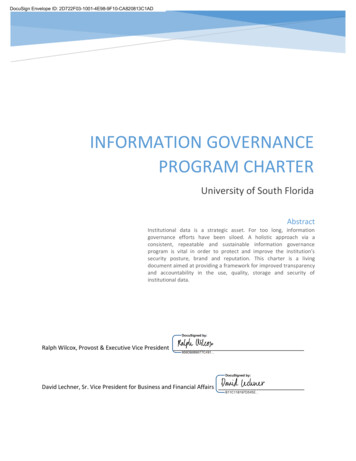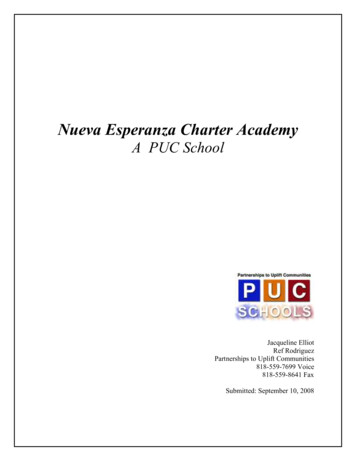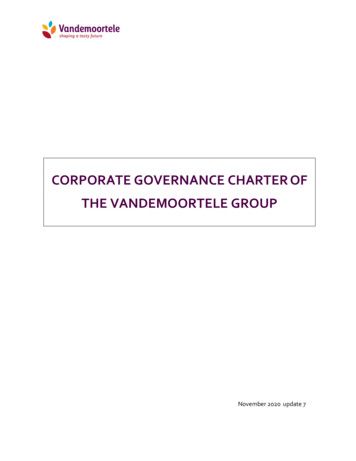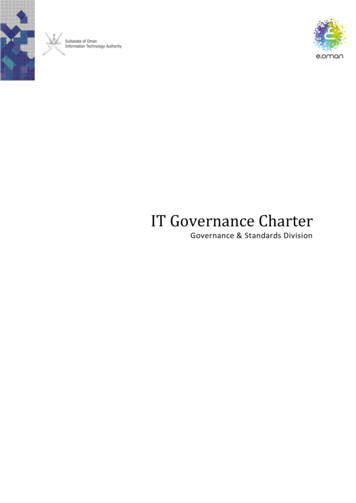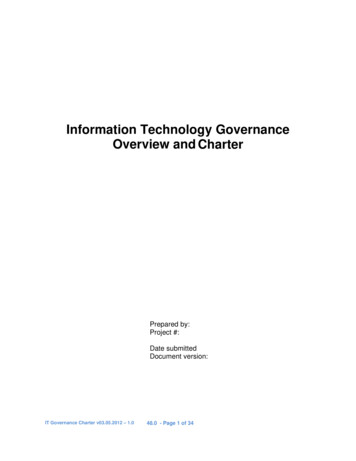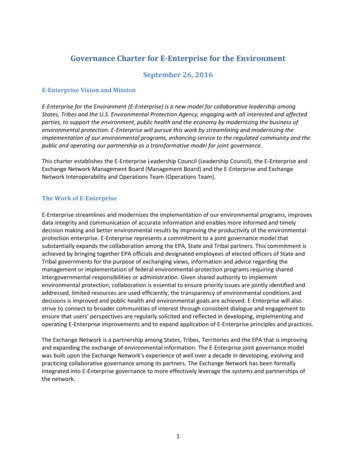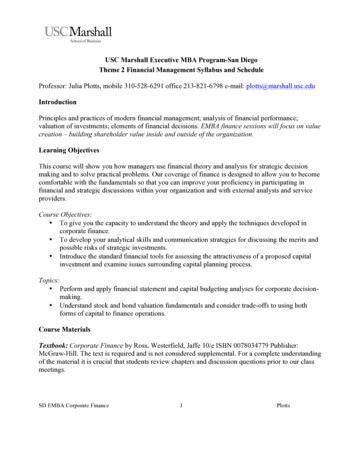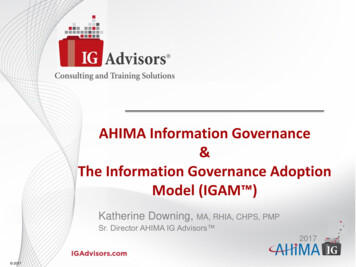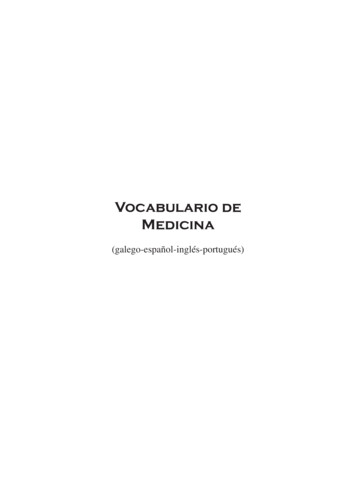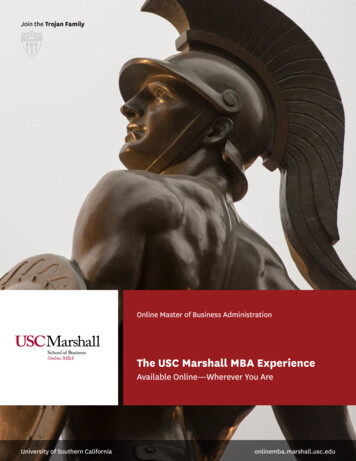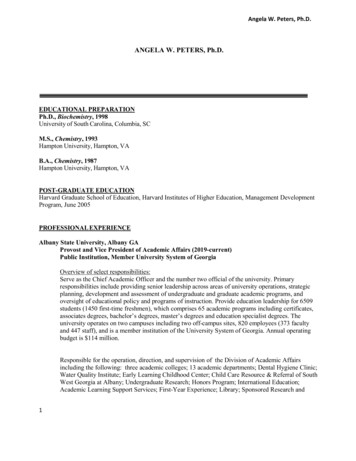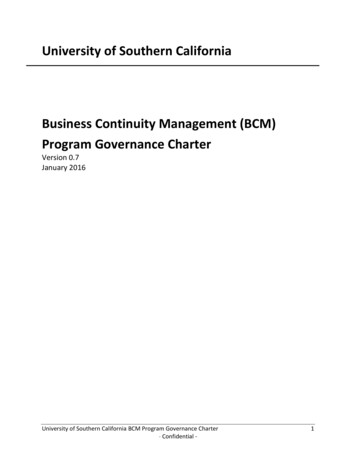
Transcription
University of Southern CaliforniaBusiness Continuity Management (BCM)Program Governance CharterVersion 0.7January 2016University of Southern California BCM Program Governance Charter‐ Confidential ‐1
Table of contentsAbout this document .1I.II.III.Document contact information . 1Revision history . 1Key Reference documentation . 11. Executive Summary 21.1 Purpose of this document . 21.2 Definitions . 21.3 BCM Mission Statement . 31.4 BCM Policy . 31.5 BCM Scope. 42. Program Governance 52.1 Governance Organizational Structure . 52.2 Roles and Responsibilities . 62.2.1BCM/DR Steering Committee (Governance). 62.2.2Administration, Academic, and Patient Care Unit BCM Teams . 72.2.3Fire Safety & Emergency Planning (BCM/DR PMO) . 82.3 RACI Summary . 93. Reporting Framework 114. Scorecard 124.1 Scorecard Elements . 124.2 Scorecard Report View . 125. Communication .135.1 Awareness/Outreach. 135.2 Reporting . 135.3 Meetings . 145.4 Decisions. 14University of Southern California BCM Program Governance Charter‐ Confidential ‐2
About this documentI.Document contact informationNameII.EmailPhone numberSummary of changesAuthorRevision historyIssue /versionIII.Effective dateKey Reference documentationVersionnumberLatest updateDocument titleAuthorV0.2Jan. 2016University of Southern CaliforniaBusiness Continuity Management (BCM)Methodology FrameworkEYUniversity of Southern California BCM Program Governance Charter‐ Confidential ‐1
1. Executive Summary1.1 Purpose of this documentThe purpose of the University of Southern California (USC) Business Continuity Management (BCM) ProgramGovernance Charter is to define the overall organizational accountability and responsibility for the management ofthe BCM Program. A key success factor for the BCM Program is the integration and coordination of efforts betweenBusiness Continuity, Disaster Recovery, and Crisis/Emergency Management, working closely with all administrative,academic, and patient care units within USC. As such, this governance model fosters commitment from USCleadership to continue to drive success.This document contains the governance framework including the mission statement, policy, scope, standards, rolesand responsibilities of program team members, RACI (Responsibility, Accountability, Consulted, Informed),reporting mechanisms to track key performance indicators (KPIs) and manage the progress of key BCM activities,and communication protocols to maintain awareness and outreach.The derived benefits of this model include the following: Enable Commitmento Active Involvement from USC leadershipo “Executive Buy‐in” to the vision to continually deliver on the goals and funding of the BCMProgram to “operationalize” and sustain the program over timeo Strategic alignment of the BCM program to USC’s mission and goals Identification and management of university continuity risks in a consistent, integrated processo Creation of a unified platform to capture and analyze risk data and metrics collected by differentareas within the universityo Deliver insights into current and future risk sources that are potentially disruptive toadministrative, academic, and patient care unitso Support administrative, academic, and patient care unit operations by focusing on businesscontinuity and disaster recovery plans in order to improve overall university operational resiliencyo Protect key sources of the university’s administrative, academic and patient care unit operationsby mitigating disruption risks with robust business continuity and disaster recovery plans Integration of Business Continuity, Disaster Recovery, and Crisis/Emergency Managemento Unified team ‐ getting rid of siloes which fosters a better sense of decision making andcollaboration and coordination of efforts to manage through an evento Alignment of roles and responsibilities before, during, and after an evento Consistent approach across Business Continuity, Disaster Recovery, and Crisis/EmergencyManagement disciplineso Fewer resources – the emphasis is on ACCOUNTABILITY of the administrative, academic, andpatient care unit leads being driven from the direction provided by emergency planning througha standard methodology, tools, enablers and communication protocols to manage through anevent.1.2 DefinitionsThe following definitions apply throughout this document: Business Continuity Management (BCM) Program: An on‐going management and governance processsupported by the Business Continuity Management Leadership Team with guidance from the BCMExecutive(s), resourced to ensure that the necessary steps are taken to identify the impact of potential losses,manage risk, develop resiliency, maintain viable recovery strategies and plans and ensure continuity of USC’sservices through exercising, rehearsal, testing, training, maintenance and quality assurance.University of Southern California BCM Program Governance Charter‐ Confidential ‐2
Crisis/Emergency Management (C/EM): A clearly defined and documented plan of action for use at the timeof an emergency or crisis. Typically this will cover both emergency response actions, as well as all the keypersonnel, resources, services and actions required to implement and manage the crisis managementprocess. Business Continuity (BC): A process of developing and documenting arrangements and procedures thatenable an organization to respond to an event that lasts for a period of time and return to performing itscritical functions after an interruption. Disaster Recovery (DR): The technical (e.g., application, network, platform, storage, dependency, etc.)component of business continuity planning to recover a data center, service, component, or application.1.3 BCM Mission StatementThe mission of USC s BCM Program is to ensure the resiliency of USC’s mission of teaching, research, and patientcare against a broad range of possible operational risks and interruptions. It establishes a process to collect andanalyse risk metrics and data to provide ongoing risk insights. It also establishes policies, processes and proceduresto enable advance preparation and actions by administrative, academic, and patient care units to mitigate risks andincrease the pace of recovery from disruptions of various magnitudes. It seeks to understand the threats and risksfrom a lack of availability of people, functions, and technology and to reduce the impact of a significant eventresulting in an unanticipated interruption of normal operations.The success of the BCM mission is achieved by delivering on the following goals: Establish commitment, leadership, oversight, and buy‐in from executives to maintain the program Establish a sound and consistent process and framework to identify and assess risks Establish policies and procedures for business continuity and disaster recovery that are best practices Prioritize criticality of administrative, academic, and patient care unit functions Continually evaluate the business impact from a financial, operational, and reputational risk perspectiveto USC’s administrative, academic, and patient care units Work with USC’s administrative, academic, and patient care units to be prepared to restore the deliveryof critical processes and supporting functions as quickly as possible Improve the quality of recovery solutions and leverage internal resources efficiently during responses Maintain the accuracy and quality of business continuity and disaster recovery plans Exercise business continuity and disaster recovery plans Establish an effective communication plan around business continuity and disaster recovery with thefaculty, staff, and students across the university Identify the resources necessary to support the program Maintain on‐going training and awareness related to business continuity and disaster recovery1.4 BCM PolicyUniversity Disaster Recovery/Business ContinuityThe university‐wide goal after a major emergency or disaster will be to restore teaching, research, patient care, andother mission‐critical activities in a timely manner. All administrative and service units shall maintain continuity ofservices to facilitate the recovery of critical functions and continuity of the university mission following a majordisruption or disaster. Assisted by emergency planning staff, all departments and academic schools will ensure thatdisaster recovery and business continuity plans are updated annually, and exercised, and communicatedappropriately to maintain readiness to implement the plans when needed. . These plans should includecontingencies to perform critical functions in the event of a loss of facilities, loss of technology, or staffing shortage,and they should identify recovery team members, responsibilities, and contact information.University of Southern California BCM Program Governance Charter‐ Confidential ‐3
Disaster Recovery of Data and Information SystemsThe university protects vital data security, and maintains backup procedures and systems to protect against loss ofvital data due to an adverse event or disaster. Information Technology Services (ITS) has disaster recovery plans andmaintains off‐site backup systems for recovery of core university‐wide data and information systems. All systemsoperated locally by departments or schools shall also ensure that vital data is backed up and stored in a secure off‐site location. Emergency planning staff, in partnership with Information Technology Services, will assist schools anddepartments in developing information backup plans as part of their disaster recovery and business continuityplans.1.5 BCM ScopeThe BCM Program administered by Fire Safety & Emergency Planning will help USC’s administrative, academic, andpatient care unit assess, develop, implement, test and maintain business continuity and disaster recovery plans forthe continued operations of critical functions and required resources in the event of disruption.To ensure consistency across the university, all business continuity and disaster recovery plans will be developedusing the consistent process, methods, tools and templates set forth in the document entitled “University ofSouthern California Business Continuity Management (BCM) Program Framework”.Fire Safety & Emergency Planning will also be responsible for reporting to senior leadership risk trends anddevelopments arising from the data collection and analysis that could result in business interruptions.University of Southern California BCM Program Governance Charter‐ Confidential ‐4
2. Program Governance2.1 Governance Organizational StructureThe main components of the governance structure are depicted in figure 1 below.President’s Cabinet / Board of Trustees Audit and Compliance tBCM/DR Steering Committee (Sponsor)InformationTechnology tionMitigationReportingMaintenancePatient CareRepresentativeFire Safety & Emergency Planning (BCM/DR PMO)Operational / Functional sentativeAdministration, Academic, and Patient Care Unit BCM TeamsDean /DepartmentHeadHR DirectorIT DirectorBusiness Officer /BudgetCoordinatorFacilities Director/ CoordinatorOther SpecializedFunction UnitLeaderFigure 1 – Business Continuity Management GovernanceUniversity of Southern California BCM Program Governance Charter‐ Confidential ‐5
2.2 Roles and Responsibilities2.2.1 BCM/DR Steering Committee (Governance)The Cabinet/Board of Trustees and BCM/DR Steering Committee (BSC), a sub‐group of the USC Crisis ManagementTeam, serves as an overseer of BCM/DR activities and has the authority to request justification of BCM/DR riskmitigation as well as plan activities. The BSC serves as the primary steering groups for the development andcontinued enhancement of the BCM Program comprised of executive management representatives from selectUSC administrative, academic, and patient care units. The BSC will escalate problems to the President’s Cabinetwhen necessary and when a school or department does not complete required business continuity or disasterrecovery actions.The BSC’s primary responsibilities include: Oversight – Reviews risks and mitigation associated with the administrative, academic, and patient careunits and technology functions.o Promote an environment of ownership and accountability of significant BCM Program risks andany correlating responses to those risks.o Authorize overall resources to meet the BCM Program objectives.o Foster a culture that captures the confidence of internal and external stakeholders.Authority – Set priorities for BCM Program execution and risk mitigation.o Serve as the steering committee for key decisions within the development and implementationof the BCM Program.o Steer formulation of policies and procedures that support university strategy.o Review and approve BCM Program objectives.o Provide consistent direction to achieve the BCM Program goals and objectives by establishingachievable targets.o Ensure that adequate resources are available to meet the BCM Program objectives.Accountability – Accountable for mitigating business continuity and disaster recovery risk to a levelacceptable by the university.o Communicate goals and objectives to administrative, academic, and patient care unit leadership.o Create and foster a culture that captures the confidence of stakeholders within theadministrative, academic, and patient care unit leadership.o Ensure the program mission is clear, understood by the administrative, academic, and patientcare unit leadership and aligned with USC’s operational objectives.o Provide governance and decision making on risk mitigation investments relating to the BCMProgram.o Link administrative, academic, and patient care unit performance and compliance with BCMProgram policy to incentives based on the BCM Program objectives.o Review quarterly reports on the status of the BCM Program.o Report the BCM Program scorecard (including performance and issues) to the Cabinet/Board.The BSC is facilitated by the USC BCM Program Director and includes the following executive representatives fromselect USC administrative, academic, and patient care units:BCM/DR Steering Committee USC BCM Program Director –Director, Fire Safety & Emergency Planning Administration Representative – Associate Senior Vice President, Administrative Operations Provost Representative , TBD Patient Care Representative – TBD Information Technology Services Representative, Vice Provost/CIOUniversity of Southern California BCM Program Governance Charter‐ Confidential ‐6
Finance Representative – TBDAdditional representatives from various other campus units, while not formal members of the Steering Committee,will be called upon to assist the Committee when necessary if they have knowledge of a specialized functionalareas of the university needed to develop strategies for planning in any given area of continuity management.2.2.2 Administration, Academic, and Patient Care Unit BCM TeamsAdministrative, Academic, and Patient Care Unit BCM Teams (Operational & Functional Team) consist ofadministrative, academic, and patient care unit representatives. The BCM Teams will work with Fire Safety &Emergency Planning (BCM/DR PMO) to facilitate, develop, test and execute the defined business continuity anddisaster recovery plans, standards and methodologies associated with the administrative, academic, and patientcare units Report BCM Program status to – Fire Safety & Emergency Planning (BCM/DR PMO)Coordinate BCM Program activities with – Fire Safety & Emergency Planning (BCM/DR PMO)The primary responsibilities include: Assessment – Ensure that units under their direction complete business continuity and disaster recoveryrisk identification and develop appropriate recovery strategies and mitigation plans. .o Identify and prioritize critical functions based upon adverse impacts to operations if theprocesses were not available.o Assist the BSC in deciding whether to accept the existing level risk or mitigate the risk byinvesting in additional resources or developing recovery strategies.o Collaborate with regular reviews, at least annually, of the business continuity and disasterrecovery plans with the administrative, academic, and patient care units to ensure they arecurrent and accurately reflect business operations.Management – Lead planning and execution of the BCM Program initiatives in support of theadministrative, academic, and patient care unit goals and objectives.o Authorize administrative, academic, and patient care unit functional resources to supportstrategy and ensure the resources are sufficient to achieve the desired results.o Remove organizational barriers to achievement.o Ensure consistency in policies and procedures, as well as alignment to the overall strategy.o Support Fire Safety & Emergency Planning (BCM/DR PMO) in reporting the program keyperformance indicators (KPIs).o Report findings and if necessary, make recommendations to Fire Safety & Emergency Planning(BCM/DR PMO).Responsibility – Responsible for communicating risks and executing mitigation plans for administrative,academic, and patient care units to the BSC.o Responsible for any issues addressed by the BSC and initiate any actions necessary to addressupcoming changes.o Assist in ensuring that units under their direction remain in compliance with business continuitymanagement re
Governance Charter is to define the overall organizational accountability and responsibility for the management of the BCM Program. . Business Continuity . Improve the quality of recovery solutions and leverage internal resources efficiently during responses .
